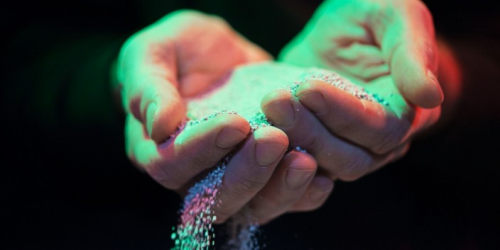
Phosphorus is essential for human life. It is also a finite resource for which there is no known substitute. Our bodies each contain about 800 grams (1.8 pounds) of the material, the second-most common mineral in our systems after calcium. Phosphorus resides in every cell and plays a central role in human metabolism, our nervous systems and skeletal health. It is also crucial for plants, helping them convert other nutrients into building blocks for growth. About 90% of the world's mined phosphorus ends as the crucial ingredient in fertilisers. With the planet's population heading towards 9 billion people by 2050, we must ensure adequate supplies of phosphorus-enriched fertilisers to grow food. The exact size of the world's phosphorus resources is unclear. The subject has been hotly debated by experts in recent years. Some argue that global supply will be depleted in 50 to 100 years and that production will peak in 2030. Others argue that the reserves will last for several hundred years. The United States Geological Survey estimated in 2012 that worldwide reserves of phosphate rock (phosphate is the inorganic form of phosphorus) are 67 billion tonnes, while world mining production in 2012 was 0.21 billion tonnes. Just as OPEC controls 75% of the world's oil reserves, some 90% of the world's mined phosphate is in the hands of a few countries: Algeria, China, Jordan, Morocco, South Africa, Syria and the United States. Morocco including Western Sahara has larger reserves than the rest of the world combined. Parts of the world, such as Western Europe and India, are totally dependent on imports.
Where phosphorus meets wastewater
While agriculture needs phosphorus, operators of wastewater treatment plants must remove it. This is to prevent eutrophication of fresh water systems. Too many nutrients in a body of water cause excessive plant growth – especially algae. The outcome means that, the resulting bacteria consumes nearly all the oxygen in the water, choking the fish and aquatic life.
The removal process presents its own problems. Phosphates – salts containing phosphorus – combine with magnesium and ammonium to create struvite, a substance that clogs pipes, pumps and other equipment. This causes production disruption and increases service costs.
In 2011, Aarhus Water Ltd, a municipal-owned company based in Aarhus, Denmark, set out to solve the problem with pump manufacturer Grundfos and technical consultant firm Norconsult. The solution they found was surprising and rewarding – recovering phosphorus and nitrogen from wastewater through the use of a separate reactor. They needed the reactor because the concentration of phosphorus and nitrogen is low in the main wastewater flow. To increase it, they send a side stream of wastewater through the reactor and added magnesium salt. The precipitation process refines the phosphorus, discarding heavy metals and environmentally unfriendly substances. The outcome is a granulate that contains phosphorus, nitrogen and magnesium – well-suited for use as a fertiliser.
The technology is now being used in Denmark's first phosphorus recovery plant, inaugurated by Aarhus Water at Aaby in November 2013. The operation produces about 50 kilograms of phosphorus daily.
.jpg) Claus Homann, chief operating officer of Aarhus Water, explains how the reactors sprinkle out 50 kg of high-grade fertiliser a day.
Claus Homann, chief operating officer of Aarhus Water, explains how the reactors sprinkle out 50 kg of high-grade fertiliser a day.
“It's new to us that we can actually make money on what we produce,” says Claus Homann. “At the same time, our operational costs are lower, we need less energy, and the amount of sludge is reduced. It sounds too good to be true.”
Commercially viable recovery
The technology for recovering phosphorus has been around since the 1980s but is not patented, says Per Krøyer Kristensen, business development manager at Grundfos. “But now it is commercially viable to build recovery plants,” he says. “The price of phosphorus has increased, and there is a general focus in the world on energy efficiency and reuse of nutrients.”
To make the Aarhus project work, Grundfos supplied seven SEV wastewater pumps, six DME 375 digital dosing pumps and one Type KD mixing unit for magnesium chloride.
Denmark's phosphorus demand for crop production requires imports of 11,000 tonnes of phosphorus. But Kristensen says recovery plants can change that. “If similar recovery plants are built at the 50 largest water treatment plants in Denmark, we can produce 3,000 tonnes of pure phosphorus fertilisers per year, representing more than 25% of the country's imports,” he says.
There is another benefit of separating phosphorus from sewage sludge. Sludge is normally distributed to farmers who spread it on their fields. But sludge is unhygienic and potentially harmful to certain types of crops and can only be used for fields where crops fed to animals are grown. Furthermore, phosphorus left in sewage sludge binds to iron and aluminium salts, which make it difficult for the plants to take up phosphorus.
The new recovery system means good business for Aarhus Water. Lower operational costs combined with sales of fertilisers mean the investment pays for itself in less than seven years. Kristensen says it also means good business for Grundfos and Norconsult, which jointly own the concept.
“The second plant is already being constructed, this time for Herning Water, another Danish municipal-owned company, and we're in the process of creating new partnerships for sales in the rest of Europe,” he says.



